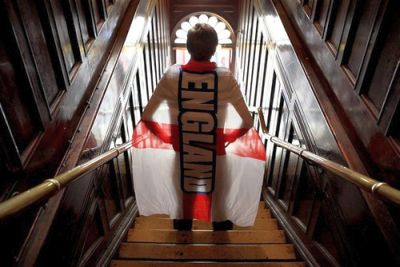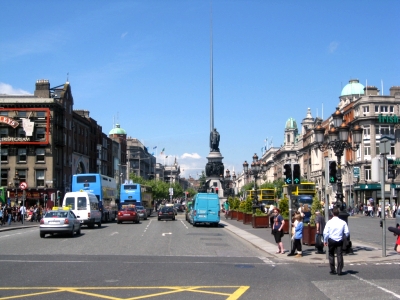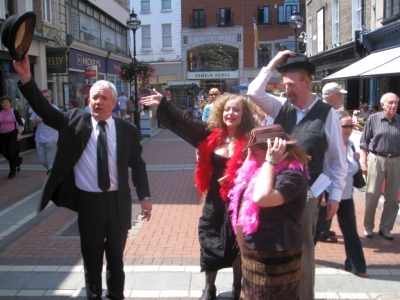Planet Cup Dispatch: Component 3 (Dublin, Far more Pints, And Joyce Fanatics)

Contributor Andrew Post is traveling in the U.K and Ireland for the next two weeks covering the Globe Cup and his trip for TheExpeditioner.com. Minus any hooligan-related incidents, Andrew will be checking in with dispatches along the way. God support him.
By Andrew Post
There are several strategies to enter Dublin. The Vikings came with swords and ships, ravaging the countryside, uniting the two Gaelic villages of Dubh Linn and Átha Cliath into a key city. The English came with daggers and promises, finishing the function that the Vikings began, putting the Irish and the new city of Dublin beneath British rule. And now, in the final couple of years, people today from around the planet — Asia, Africa, continental Europe — have come to Ireland to develop new lives, bringing market and exotic foods and foreign spice, lending a dash of international flavor to an currently culturally wealthy metropolis.
My buddy and I decided to come to Dublin with a hangover.
Where’ve All The Irish Gone?
In less-than-triumphal progress, Jeff and I stepped off the Ryanair jet and into the terminal at Dublin Airport. We have been broadsided by the apparent Irishness quickly. All the airport signage was bilingual: Gaelic in prominence, printed in jaunty shamrock green, with English in white, taking a small, secondary spot beneath.
We’d left comforting Newcastle far behind and entered a foreign land, no longer aspect of the U.K., exactly where the euro ruled and age-old tensions nevertheless lurked in the shadows.
Yes, we thought, we’re here. This is the true thing. We’re about to get a taste of the Ireland we’ve heard about from Joyce and McCourt.
That illusion started to dissolve as we stepped across the threshold of our hostel, just east of the Temple Bar district of Central Dublin, south of the River Liffey, on College Street.
The young lady behind the reception desk was Australian.
So was our roommate, Harry. A Melbourne man, backpacking across Europe, he was the most dapper hiker we’d ever run across. He was by no means without having his waistcoat and button-down shirt, or a fancy sweater laid over a starched collar.
Undaunted by exhaustion, Jeff and I resolved to set out on the town and see some thing of the spot prior to the slowly setting sun gave out on us. Our hostel was ideally situated: suitable subsequent to the stunning campus of Trinity College, itself adjacent to the Bank of Ireland. Both establishments had been monolithic, constructed in the Georgian style. The bank resembled the Parthenon, with 50-foot columns sheltering a pair of humble ATM machines. The college was positively palatial, statuary sprouting from green lawns, the roof soaring skyward, impressive stone facade dotted with windows, and numerous impressive arches major into a central courtyard.
 The whole city of Dublin displayed a strongly Georgian influence, with many buildings decorated with columns, carvings and inscriptions. Just a block more than from our hostel, north of the Liffey on O’Connell Street, stood the statue of Daniel O’Connell himself, the Irish hero who repealed a lot of of the restrictive laws place in place by the British. Behind him, a handful of blocks additional on, the Spire of Dublin reared into the sky, hundreds of feet tall, its silver skin gleaming in the uncommon Irish sun. Intermingled with these grandiose structures had been quite a few much more modern day buildings, city offices and towers, lending a weird juxtaposition of old and new to the city. Throw in three million comfort retailers, quickly food joints, shops and pubs, and contemporary-day Dublin comes into view.
The whole city of Dublin displayed a strongly Georgian influence, with many buildings decorated with columns, carvings and inscriptions. Just a block more than from our hostel, north of the Liffey on O’Connell Street, stood the statue of Daniel O’Connell himself, the Irish hero who repealed a lot of of the restrictive laws place in place by the British. Behind him, a handful of blocks additional on, the Spire of Dublin reared into the sky, hundreds of feet tall, its silver skin gleaming in the uncommon Irish sun. Intermingled with these grandiose structures had been quite a few much more modern day buildings, city offices and towers, lending a weird juxtaposition of old and new to the city. Throw in three million comfort retailers, quickly food joints, shops and pubs, and contemporary-day Dublin comes into view.
. . . except, of course, for the bewildering lack of Irish people.
Jeff and I split up. I went down O’Connell Street, across the river, to search for an internet café Jeff went the opposite path, farther down College Street, to search for a pharmacist. Each of us were nonetheless feeling rotten. I stumped my way across the O’Connell bridge, wide as it is lengthy, marveling at the pedestrian crossings, exactly where the green man not only lights up, but tends to make a noise like a laser beam to inform you when it is time to dash across. The streets had been just as narrow and crowded here as in London, and double-decker buses warred for area with scooters, taxis, modest automobiles, and hundreds upon hundreds of people.
The accents had been from all over, but I didn’t hear an Irish one in the bunch. I heard English, Australian, and American accents additional than something else. I could never be certain, when hunting at a comely female (of which there had been numerous in Dublin), no matter if they were my compatriots or not. It was not possible to inform by looking. Trendily-dressed girls have been everywhere, sporting skirts and heels in light of the attractive spring climate. There have been men in polo shirts, businessmen in suits, rough-seeking males in tank tops and tattoos, elderly girls shuffling their serene way down the sidewalk, young couples strolling hand-in-hand, mothers pushing strollers down the sunny streets, sunglasses and quick sleeves on absolutely everyone. The weather was beautiful, a warm sun, a cool breeze, temperatures around 70 degrees Fahrenheit, the skies blue as the Irish Sea.
It felt like Ireland. It just didn’t sound like it.
The Oldest Pub In Ireland (Perhaps)
Jeff and I met up back at the hostel, and soon after an hour’s nap we felt nicely adequate to venture out on the town for a pint. We were searching for a appropriate Irish pub, thoughts you. There’d be the subsequent day for tours and pub crawls, but tonight we just wanted a quiet pint to detoxify with. Over a no cost lunch of pasta and salad, we heard rumors of the ideal candidate: the Brazen Head. It possessed all the fixings: brick walls, dark wooden rafters, climbing ivy, an outside patio, Guinness on tap, the performs. So out we went.
After about 30 minutes of wandering aimlessly about Temple Bar, trying vaguely to recall the directions we’d been offered, hunting about cathedrals, twisting side streets, back alleys, theaters, and hotels, we discovered it. The sign, painted on the whitewashed stone wall of the building suitable, proclaimed it to be the oldest pub in Ireland, established 1198. No matter whether that was true was anyone’s guess. (Later on, we would find out a pub north of the river that claimed to be the oldest pub in Dublin, so unless there was some unprecedented expansion of the city boundaries just after the Viking invasions, one particular of the two was wrong.)
Let’s just settle the bet proper now: Guinness truly tastes great in Ireland. The ideal cause we heard for this was that Guinness breweries in Ireland are permitted to use the finest ingredients stored in the Irish warehouse the rest of the world’s Guinness breweries need to use the inferior stock in Norway. That being mentioned, the difference in taste and texture involving Irish Guinness and, say, American Guinness is astounding. The beer is so smooth, so flavorful, so significantly significantly less bitter and flat, with such a soft and creamy head, as to make the drinker’s previous practical experience with Guinness utterly meaningless. I took a sip, looked down, and saw that a excellent impression of my upper lip had been left in the foam, as if it had been modeling clay. The coffee-ish overtones of the beer had been excellently buoyed up by an understated bitterness and a strong finish. It was the most satisfying stout I’d tasted in many a month. Jeff and I had a relaxing drink, watching Brazil beat North Korea as the sky darkened to its northern purple hue.
“Is It All Suitable If I Definitely Stick The Knife In?”
The next morning, energized by a good night’s rest and a no cost breakfast of toast and cereal, we joined the group of people heading out for the free of charge walking tour. We assembled in a little square just up the road, close to City Hall. Our tour guide, Cillian, was the 1st Irish person we’d met. He led us up the street and to the left, stopping outdoors the gates to Dublin Castle. He stopped, turned, and bid us gather about. And then, rubbing his hands collectively and rocking back and forth on his feet, speaking promptly and resonantly in an accent that would’ve had any 17-year-old American girl swooning, he explained a couple of issues.
“Welcome to Dublin,” he mentioned, “and the Republic of Ireland, independent because 1916. WAAAAAAAAAAAAY!” he cheered.
The vacationers looked at each other and smiled nervously.
“My name’s Cillian,” he went on. “That means ‘little church’ in Gaelic. I’m going to attempt to give you the 11,ooo-year history of Ireland in the next 30 minutes. I speak quite rapid, so if any of you have problems understanding, just inform me and I’ll slow down. Can everybody hear me okay?”
Absolutely everyone could, and Cillian went on.
“I’m just going to start off by taking a fast survey of the audience right here,” he mentioned, his freckled face alight, his eyes sweeping about the semicircle of individuals gathered prior to him. “What nationalities do we have represented in the crowd now?”
“U.S.”
“Australia.”
“Australia.”
“Canada.”
“U.S.”
“France.”
“France.”
“Australia.”
“Australia.”
“Australia.”
“U.S.”
“Canada.”
“No fighting between the U.S. and Canada, okay?” Cillian joked, looking at Jeff and me. He turned back to the crowd. “I didn’t notice that we had any English people right here today, suitable? So is it all appropriate if I seriously stick the knife in?”
We all grinned and nodded, so Cillian went ahead. He launched into a soliloquy on Ireland’s history, beginning in the Stone Age, when the initial inhabitants of Ireland arrived by land bridge and boat, and moving on up into much more subjective matters.
“Then anything occurred that not a lot of Irish men and women were delighted about,” Cillian said, just after he’d finished with the Vikings. “The English came.”
It seemed that the Gaelics colonized Ireland, and had been in turn attacked and subjugated by the Vikings. Then the English, led by the Anglo-Norman named Strongbow, came to Ireland and announced that they were now in charge. Factors have been peaceful for a although, with the Anglo-Normans settling into Irish strategies, learning the Irish language, marrying into Irish families, and becoming, as the man when stated, “more Irish than the Irish themselves.”
That didn’t sit properly with the English, even though, and they put severe restrictions on Catholics (i.e., the Irish) and barred them from holding workplace and fundamental rights. Hence the Troubles, which plagued Ireland for years. The Irish Civil War followed straight on the heels of the War of Independence, and has by no means officially come to an end.
Cillian didn’t pull any punches when it came to the English contribution to all this.
Then he led us all about Dublin, by means of the castle (which additional resembled a mansion), telling us the interesting stories about the statues there, and how they symbolize British imperialism previous the records tower, the only castle-ish thing in sight, where a captured Irish prince was held for 5 lengthy years prior to escaping into the Dublin Castle Park, the finest-kept secret in the city, the quietest and most secluded park imaginable. Then to Christ Church Cathedral, a attractive piece of Neo-Gothic architecture (initially constructed of wood by the Vikings), genuinely an awe-inspiring sight.
We perused Dublin’s New Theatre, where U2 was discovered, and the Clarence Hotel across the street, which kicked U2 off their premises for being too scruffy. The band vowed to personal the location someday, and returned just after striking it big, buying the hotel. Cillian told us that he’s usually noticed The Edge possessing a quiet drink in the hotel bar.
The tour ended, and Jeff and I had 3 hours to reduce loose and see Dublin just before the hostel-sponsored pub crawl at 7:30. I paid six euro to enter the Christ Church Cathedral — I couldn’t resist. It was worth every cent. I saw the tomb of Strongbow the solid gold communion service set which James II granted the church the dimly-lit crypt, sheltering the memories and markers of these centuries dead the mummified bodies of a cat and a rat which a janitor found in an organ pipe and the cathedral itself, soaked in grandeur and tradition.
 Unkowingly, we’d hit town in the course of Bloomsday, June 16, when the Joyce faithful turn out to reenact his epic novel, Ulysses. Groups of bowler-clad, bespectacled actors roamed the streets, randomly reproducing scenes from the controversial novel. We stopped by 1 crowd of people today gathered about a specifically prosperous troupe, watching the action without the need of knowing what was going on, but loving it nonetheless. The scene ended, everybody applauded, and we all walked away vowing to read the book someday.
Unkowingly, we’d hit town in the course of Bloomsday, June 16, when the Joyce faithful turn out to reenact his epic novel, Ulysses. Groups of bowler-clad, bespectacled actors roamed the streets, randomly reproducing scenes from the controversial novel. We stopped by 1 crowd of people today gathered about a specifically prosperous troupe, watching the action without the need of knowing what was going on, but loving it nonetheless. The scene ended, everybody applauded, and we all walked away vowing to read the book someday.
Then it was on to the Old Jameson Distillery for a tour. The new distillery has moved south, but John Jameson’s original facility has been preserved as a museum. Becoming a not too long ago-minted bartender, and however understanding nothing of the actual distillation procedure, the tour was extremely enlightening, despite the parsimonious anti-Scotch propaganda. At the finish of the tour, I volunteered for the tasting ceremony. I and seven other intrepid souls — none of them Irish — tested Jameson against Jack Daniels (representing American whiskey) and Johnnie Walker Black Label (representing Scotch whisky). Of the 3, Jameson was my favored, so I answered honestly, pushing the empty center glass forward and thereby receiving the approbation of the tour guide, Georgina — and a certificate with my name on it, indicating that I was now a whiskey connoisseur.
Georgina was the second Irish person Jeff and I met even though we had been in Dublin.
After a rapid run to the hostel for a shower and a transform of garments, we all rendezvoused at the Purty Kitchen, a pub/club in the center of Temple Bar. Beers had been totally free till eight, so we dashed back and forth among the bar and the chaperone with the cost-free beer tokens, displaying a red piece of paper to the former and our empty glasses to the latter.
We downed about 5 rounds in 30 minutes, doing our ideal to meet and greet with fellow foreigners whilst Uruguay socked it to South Africa on the television. I joined up with a trio of Australians and had a extended chat as we got progressively extra buzzed. Then it was onto Kearney’s, exactly where I got my initially taste of beer pong. Actually my very first taste, as Jeff and I came up against a pair of Oklahomans who schooled us in the art of defeat. Jeff and I, heads starting to spin, sat at the downstairs bar and chatted with a couple of ladies from Maine, questioning how we got ourselves into this mess, and exactly where all the feckin’ Irish folks were.
Much more pubs, additional beers, much more shots, and a steamy, sweat-laden club session later, Jeff and I stumbled household, clumsily undressed, and collapsed onto our beds, alarm clocks forgotten, hoping that we would somehow be sober enough in the morning to navigate our way to the bus station and the airport. We had been blindsided by the goodness of Guinness, astounded by the mythic scale and antiquity of Dublin. We had hit pretty much all the big landmarks we’d wanted to, been blessed with rare excellent climate, and had located our way about in spite of all odds.
The climate was alien, the company foreign, the welcome anti-British, but the party (or, as they say in Gaelic, the craic) was all Irish.
We’d settle for that.

Coming Next In Aspect Three: Departing Dublin (the National Museum), an outdoor picnic in Newcastle, and how to host an American barbecue in England. Just after that…the train to Edinburgh, haggis, and Scottish weekend nightlife.
Study Portion A single Right here
and Element Two Right here
Comments
Post a Comment